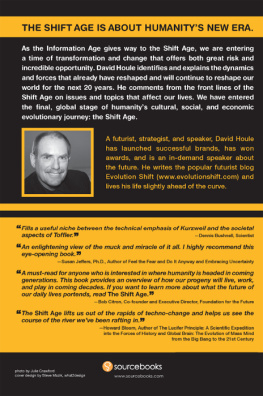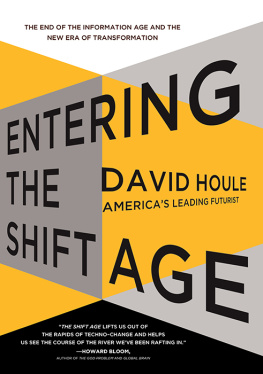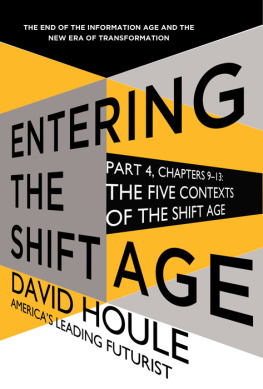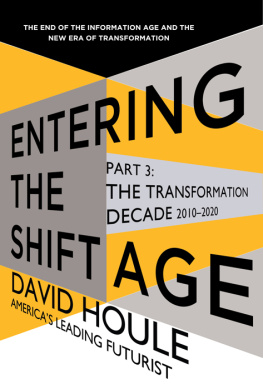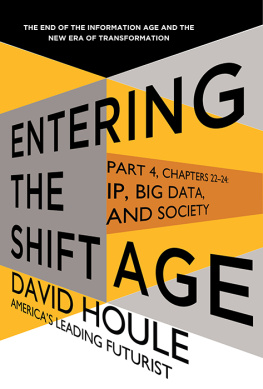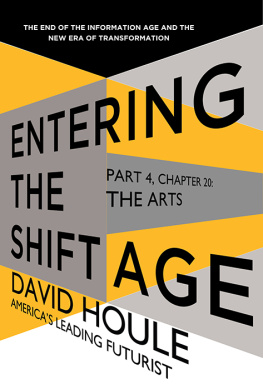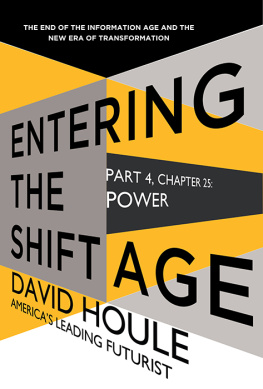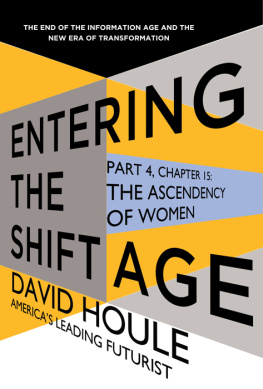

Copyright 2012 by David Houle
Cover and internal design 2012 by Sourcebooks, Inc.
Cover design by Studio Gearbox
Sourcebooks and the colophon are registered trademarks of Sourcebooks, Inc.
All rights reserved. No part of this book may be reproduced in any form or by any electronic or mechanical means including information storage and retrieval systemsexcept in the case of brief quotations embodied in critical articles or reviewswithout permission in writing from its publisher, Sourcebooks, Inc.
This publication is designed to provide accurate and authoritative information in regard to the subject matter covered. It is sold with the understanding that the publisher is not engaged in rendering legal, accounting, or other professional service. If legal advice or other expert assistance is required, the services of a competent professional person should be sought. From a Declaration of Principles Jointly Adopted by a Committee of the American Bar Association and a Committee of Publishers and Associations
All brand names and product names used in this book are trademarks, registered trademarks, or trade names of their respective holders. Sourcebooks, Inc., is not associated with any product or vendor in this book.
Published by Sourcebooks, Inc.
P.O. Box 4410, Naperville, Illinois 60567-4410
(630) 961-3900
Fax: (630) 961-2168
www.sourcebooks.com
CONTENTS
PART 4
THE FUTURE OF
THE SHIFT AGE
In Part Four, we will look at the future by first focusing on some large concepts and contexts of the Shift Age, followed by a close look at particular segments of society and humanity.
In Part Two, we looked at the three dominant forces of the Shift Age: the Flow to Global, the Flow to the Individual, and Accelerating Electronic Connectedness. These three forces are driving several big ideas that are initiating massive change now, and will have largely reshaped our world by the year 2025.
One clear difference between the Information Age and the Shift Age is content and context. The true clich of the Information Age was content is king. The reality of the Shift Age is context is king. Entering the Shift Age, we live in an increasingly contextual world. I have selected the five contexts I think have the greatest impact and influence.
THE FIVE MAJOR UNDERLYING CONTEXTS OF THE SHIFT AGE
1.The Earth Century
2.The need to retrofit the twentieth century
3.The Concept of Place has changed forever
4.The merging of biology and technology
5.The move toward an evolutionary shift in human consciousness
So now let us begin by taking a look at these five contexts, and then explore what much of society will look like in the years and decades ahead. Some of the areas we will explore the future about are Shift Age Generations, Education, Technology, Energy, Brands and Marketing, the future of the Nation-State, and Powerall areas that will have transformational change.
Its time to enter the Shift Age and our collective future.
CHAPTER TWENTY-ONE
BRANDS AND MARKETING
Brands and their marketing will change significantly in the Shift Age. A good bit of this change has to do with the fact that the Shift Age is basically coincidental with the beginning of the twenty-first century. The twentieth century was the century of media as we know it. Newspapers reached unprecedented mass, radio reached into the home, movies became mass entertainment, and television changed the world, followed by cable television. Finally, in the last decade of the century, the Internet brought the century and media as we knew it to a transformative close.
Brands and marketing were completely shaped and driven by this media-centric century, as it was media that allowed marketers to create branding through it. Much of the legacy thinking that defined brands and marketing was formed in the last fifty years of the twentieth century. However, in the twenty-first century and now the Shift Age, all of these definitions and axioms are being challenged and destroyed. The Internet has assumed supremacy. It has subsumed many formerly dominant individual media forms from the last century and instead is becoming their connective tissue. It certainly has fundamentally changed consumer behavior, and of course it is to the consumer that brands are marketed.
Brands through the Ages
We need to take a larger historical step back to look at brands, as much of what is about to happen to them in the Shift Age will in some way be analogous to their earliest stages.
Brands and trademarks predate the modern era and capitalism. They began to appear when long distance commerce began. Initially people exchanged goods locally and therefore tended to have personal connections to the local producer whose business reputation was known and who had an interest in maintaining ongoing trade relationships. When people began to trade long distance, this personal guarantee and reputation was no longer available, and various forms of marks were used to help ensure the buyer of the quality and quantity of the goods being sold. Then, sometime around 5,000 years ago in ancient Mesopotamia, with the structured beginning of long-distance trading, elemental brands, or marks, were used to represent the origin of the product or the maker as one whose reputation or quality had been established.
When the Industrial Age began brands took off. Mass production enabled large-scale production of goods, and steam-powered transportation vastly increased the breadth and speed of distribution. This was when still-existing brands such as Bass Ale in 1876 and Coca-Cola 1887 were trademarked, and Quaker Oats was trademarked as the first breakfast cereal in 1895.
Brands really came into their own in the twentieth century, particularly in America. This was when mass markets were created with the aforementioned media, and mass production further drove down production costs, eliminating the local supplier. Brands became large and national and then, later in the century, multinational.
Brands were institutional and had institutional authority. They were large, defined categories and were corporate. Ivory was 99 percent pure, Tide was the laundry detergent for the family. The Good Housekeeping seal of approval was a mark of authority and acceptance. This was particularly true when television grew to dominance in the middle part of the century. Brands sponsored entire shows and then moved to the thirty-second commercial, a model still largely in place today.
However, there is disruption that is clearly present with brands as we enter the Shift Age. This is due in large part to the fragmentation of media over the last thirty years. It is much harder for a company to reach the full potential audience for its brand. In addition, with the advent of social media, the institutional power of brands has been greatly diminished.
We have moved from a twentieth-century America, and world, that was largely driven by institutional authority to one today that is often driven by personal authority, as in Ill ask my friends what they think first.
This ascendant power of networked friends who seek each others opinion greatly decreases the almost godlike authority of brand marketers of several decades ago.
Through the past few years I have been working with Owen Shapiro a partner at Leo J. Shapiro & Associates, a well-respected market research firm. He has provided me with insights into how the ideas I first presented in The Shift Age , the Three Forces of the Shift Age primarily, have been manifested in consumer behavior, in the effect of personal technology now has on purchasing decisions, and how much institutional authority has moved to personal authority.


